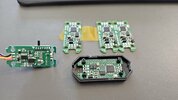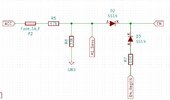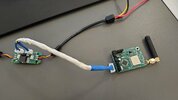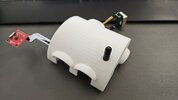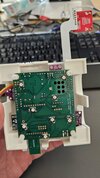Update #3:
Unfortunately this one is without any photos or screenshots. Finally got my lab power supply and was able to do some experimenting with different voltages as well as adding extra resistive load to the circuit. The only final test that I could not perform in its entirety was reading voltage ripple at the output of the buck converter as well as at the camera end (however I did some high level experimenting).
Here are some power stats of A129 PRO (running at 1440p/30fps) via HK3-Homebrew supplied with 12.5v:
ACC ON: ~ 265mA / 3.3W
ACC OFF (3fps time-lapse parking mode ): 215ma / 2.7W
Maximum temperature of the buck module ever recorder with extra 100mA resistive load (literally bunch of resistors shorted at around ~60ohm) was under 42C. Normal running at room temperature is 38-39C, so there is a lot of headroom on the heat front.
There was no significant difference in power consumption or temperatures when I powered the module with 12v vs 14.5v (max expected on my car).
Low voltage shutdown works flawlessly! The difference between actual voltage at the input of the module and the module calculated is under 5mv. After the disconnect, the whole circuit consumes only around 20uA (25uA is expected per DC module datasheet). What is interesting is that the wire supplied with HK3 kit that runs from battery to the DC module itself causes 5mv drop (so the total difference between the reading and the supply end is close to 7-10mv - totally ok with me as a buffer).
Now for the grey are - ripple voltage. Obviously the answer would come if I had an oscilloscope at hand, but since I don't have one, I had to improvise! I've tried measuring the output ripple voltage a few different ways and at the different ends and got very similar results. One method was using digital voltage/current IC same to the one used in my module and polling it at its highest frequency. The second approach was using a digital multimeter set in AC mode. Both showed very similar results! At the output end of the module, ripple voltage was around 20mV, however at the output end of the wire that leads to the dashcam (well in fact GPS contacts of the camera, so wire + dashcam) the ripple reading was between 100 and 200mV. I have also observed that "ripple" is a lot lower when the dashcam screen is on! Apparently the wire plays a big role in this, but this also can be caused by the type of voltage regulation used inside of A129 Pro. I thought A129 uses linear regulator, but now not so sure about it. If anyone has any insight on A129 Pro internals - this would be highly appreciated!
Next steps are setting up LoRa transceiver and testing telemetry range (I kind of did this already with other devices and expecting 200-300m range) and installing everything in the car.
Below is the sample data I'm reading from the module right at this moment:
22:27:00.047 -> Temp: 37.75 TempMax: 38.63 TempMin: 33.69 BatV: 12.42 BatVMax: 14.45 BatVMin: 12.31
With exception of forgetting about that one resistor mentioned in the post above, I believe this project is a success

! (I've also found a way to use more accessible and cheaper parts, but at the moment don't really see a financial incentive to pursue the whole thing as commercial project unless someone wants to collaborate).

